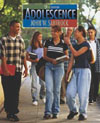1. About a century ago G. S. Hall wrote that adolescence was an especially stressful period of time, a stereotype that continues today as evidenced in media representations of adolescence as well as in literary works. Adolescents often are portrayed as interested only in drugs, engaging in promiscuous and risky sex, and alcohol abusers. What is the evidence about the percentages of adolescents in these categories that you can cite to refute the stereotype? http://www.druglibrary.org/schaffer/dea/stats/index.htm (Click on the category of interest.) 2. You are a student teacher for Ms. Masterson, who teaches tenth grade English. She is trying to capitalize on the vast store of information on the web by helping students integrate web resources into their papers. Knowing that it is important to think critically when gleaning information from the web, Ms. Masterson asks you to help her formulate guidelines students can use to evaluate web sites. What clues will you suggest Ms. Masterson provide her classes to help the students evaluate web site information? http://mciu.org/~spjvweb/evalwebstu.html http://www.lesley.edu/library/guides/research/evaluating_web.html 3. Our version of adolescence evolved because of a variety of social reforms, including child labor laws that limit adolescent involvement in the work force. When you took your first job you likely were limited in the kind of work you could do because of these laws. Do you think they are fair? How would you argue for a more individual case-by-case application of these laws? http://www.nclnet.org (Click on Child Labor Coalition) | 


 2003 McGraw-Hill Higher Education
2003 McGraw-Hill Higher Education

 2003 McGraw-Hill Higher Education
2003 McGraw-Hill Higher Education